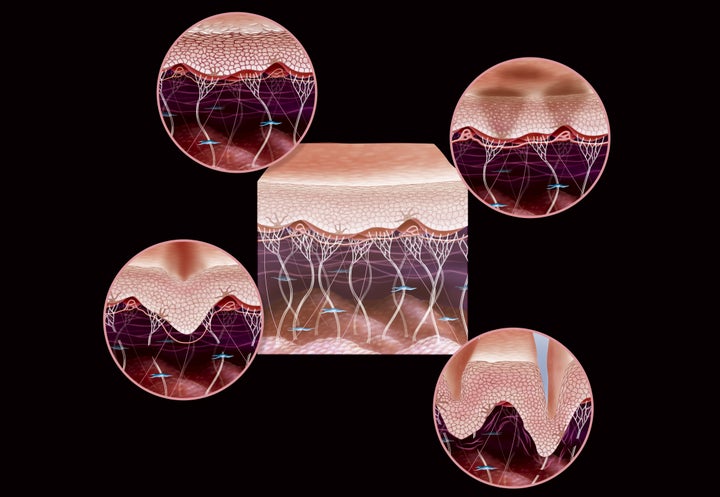Waiting for my Botox appointment in a posh medical spa in San Francisco, I started chatting up the 20-something woman sitting next to me. With her flawless skin and apparently amazing genetics (sky-high cheekbones and full lips), I couldn’t figure out what she could possibly need done at a medical spa. Perhaps she was waiting for a friend?
“I’m here for Ultherapy,” she shared.
Now I was really confused. With 65-year-old Christie Brinkley as its spokesperson, collagen-stimulating Ultherapy is a non-surgical treatment that uses micro-focused ultrasound to lift and tighten loose skin. According to their website, typical Ultherapy candidates are usually in their 30s and older, and have mild to moderate skin laxity.
Since she seemed young, and in her prime collagen-producing years, I had to ask, “Why on earth do you need that?”
She flashed a knowing smile. “Oh, I’m banking my collagen for when I need it.”
I had so many questions. What does that even mean? Where is her skin keeping these treasure troves of collagen? Does her skin actually benefit from doing this anti-aging treatment so young? Is this a real thing or a marketing gimmick?
Apparently it depends who you ask.
“Using the term ‘banking collagen’ is really just catchy wording to grab attention,” explained Annie Chiu, a cosmetic and general dermatologist in Redondo Beach, California. “The idea is based off of the trend towards ‘prejuvenation’ vs. rejuvenation.”
Collagen banking isn’t what it sounds like: You’re not removing collagen from your body and saving it in a storage vessel for later use. Instead, it refers to the idea of boosting collagen production now so your body will have more later, when your skin begins showing signs of aging.
Chiu thinks it can be a good idea to get collagen-stimulating treatments in your 20s to mitigate future collagen loss. “It is well studied that the body starts losing more collagen during the late 20s,” she explained. “This is when enzymes that break down collagen start increasing in activity beyond what the body naturally replenishes — essentially collagen breakdown outpaces new collagen production. And if you start replenishing early, you can better keep up with the rate of loss.”
Ultherapy isn’t the only way you can replenish collagen. Microneedling with platelet-rich plasma, dermal fillers like Sculptra Aesthetic and Radisse, radiofrequency treatments like Thermage, chemical peels and LED light therapy are all evidence-backed treatments for stimulating collagen production.
New York City-based dermatologist Macrene Alexiades also believes these types of treatments can help stave off looming wrinkles. “Collagen fibrils get packed into the dermis” during these treatments, which makes the skin thicker, she said. The skin draws on that collagen from the start, and wrinkles don’t appear until collagen sinks below a certain level. “Thus, extra collagen buys you more time.”
Who’s getting this done?
Millennials have been proactive when it comes to sstaving off obvious signs of aging. A 2018 survey from the American Academy of Facial Plastic and Reconstructive Surgery found that cosmetic surgery or injectables in patients under age 30 had increased 24 percentage points since 2013.
“The idea here is to create the strongest skin foundation possible while your skin cells are still functioning optimally,” said New York-based dermatologist Joshua Zeichner. “Unfortunately there is a disconnect between the time that most skincare treatments may be most effective and the time when people can afford to do them. Especially when we are addressing skin texture and elasticity, it may be best to treat the skin” in its prime — which is in your 20s or 30s for most people.

Dr. Chris G. Adigun, a board-certified dermatologist based in Chapel Hill, North Carolina, also sees value in 20-somethings stimulating collagen production.
“Collagen gives the skin structure and prevents wrinkling, thus more collagen is always good for skin health and slowing the aging process,” Adigun said. “Doing these treatments when your body is still able to generate collagen theoretically will yield improved skin health long term. It’s like a glass of water with a leak. If you keep refilling it you always have some water.”
The case against prematurely “banking” your collagen
But theoretical benefits aren’t enough for some dermatologists and surgeons to justify performing these treatments on younger patients.
New York City dermatologist Michele S. Green for the most part won’t perform Ultherapy and Thermage on the younger set. “I won’t do [Ultherapy] on a 25-year-old unless there is a particular reason. It’s classically done in your 30s and 40s when you start losing collagen.”
“There is only hypothetical scientific basis at this point,” said Mitchel Goldman, a dermatologist in San Diego. “Equally hypothetical, it could be worse in the long-run.”
Patrick Byrne, the head of facial plastic and reconstructive surgery at John Hopkins Medicine, believes that there could be such a thing as stimulating too much collagen, which could create scar tissue. “Young patients sometimes suffer injuries to the soft tissue of the face and we see that they can generate a more robust collagen response than older patients. This can lead to thicker scars that take longer to fully fade. Whether or not this is a concern with these types of treatments remains to be seen.”
Though experts differ over whether minimally invasive treatments like Ultherapy are useful, they all agreed that the most important thing younger people can do for skin is to prevent oxidative damage through good-skin practices, like a daily routine of antioxidant-rich skincare and sunscreen.
As for our Ultherapy-treated 20-something friend from the waiting room, Phillip R. Langsdon, president of the American Academy of Facial Plastic and Reconstructive Surgery, takes the “if it ain’t broke, don’t fix it” approach. “I do not see any evidence to justify treating young people who do not yet” show signs of aging.
As always, seek a certified medical professional if you’re considering any collagen-stimulating treatments.
